Embankment Displacement PLAXIS Simulation and Microstructural Behavior of Treated-Coal Gangue
Abstract
1. Introduction
2. Materials and Methods
2.1. Preparation for Samples
2.2. Test Methods
2.3. Mohr-Coulomb Model
3. Results and Discussions
3.1. Displacement Cloud Model
3.2. Interface Shear Stress
3.3. Displacement of Slope Toe
3.4. Factor of Safety
3.5. Excess Pore Water Pressure
4. Microstructure Experiments and Analysis
4.1. SEM and EDS Spectrum
4.2. Raman Spectrum
4.3. Microstructural Mechanics
5. Conclusions
Author Contributions
Funding
Conflicts of Interest
References
- Tang, Z.; Li, W.; Ke, G.; Zhou, J.; Tam, V. Sulfate attack resistance of sustainable concrete incorporating various industrial solid wastes. J. Clean. Prod. 2019, 218, 810–822. [Google Scholar] [CrossRef]
- Humsa, T.; Srivastava, R. Impact of rare earth mining and processing on soil and water environment at Chavara, Kollam, Kerala: A case study. Prog. Earth Planet. Sci. 2015, 11, 566–581. [Google Scholar] [CrossRef]
- Jiang, L.; Liang, B.; Xue, Q.; Yin, C. Characterization of phosphorus leaching from phosphate waste rock in the Xiangxi River watershed, Three Gorges Reservoir, China. Chemosphere 2016, 150, 130–138. [Google Scholar] [CrossRef] [PubMed]
- Zhang, J.; Sun, C.; Dong, H.; Cao, Y.; Zhou, S.; Guo, Z.; Fan, W. Exploration of comprehensive utilization of coal gangue resource in Daqing Mountain. Multipurp. Util. Miner. Resour. 2017, 2, 8–11. [Google Scholar] [CrossRef]
- Xia, B.; Wang, X.; Zhang, Y. Synthesis of zeolite adsorbents by coal gangue in Erdos. Bull. Chin. Ceram. Soc. 2018, 37, 1462–1466. [Google Scholar]
- Yao, Y.; Li, Y.; Liu, X.; Jiang, S.; Feng, C.; Rafanan, E. Characterization on a cementitious material composed of red mud and coal industry byproducts. Constr. Build. Mater. 2013, 47, 496–501. [Google Scholar] [CrossRef]
- Salguero, F.; Grande, J.; Valente, T.; Garrido, R.; Torre, M.; Fortes, J.; Sanchez, A. Recycling of manganese gangue materials from waste–dumps in the Iberian pyrite belt-application as filler for concrete production. Constr. Build. Mater. 2014, 54, 363–368. [Google Scholar] [CrossRef]
- Amir, M.; Morteza, R. Application of coal waste powder as filler in hot mix asphalt. Constr. Build. Mater. 2014, 66, 476–483. [Google Scholar] [CrossRef]
- Duan, X.; Xia, J.; Yang, J. Influence of coal gangue fine aggregate on microstructure of cement mortar and its action mechanism. J. Build. Mater. 2014, 17, 700–705. [Google Scholar] [CrossRef]
- Dong, Z.; Xia, J.; Fan, C.; Cao, J. Activity of calcined coal gangue fine aggregate and its effect on the mechanical behavior of cement mortar. Constr. Build. Mater. 2015, 100, 63–69. [Google Scholar] [CrossRef]
- Wang, C.; Ni, W.; Zhang, S.; Wang, S.; Gai, G.; Wang, W. Preparation and properties of autoclaved aerated concrete using coal gangue and iron ore tailings. Constr. Build. Mater. 2016, 104, 109–115. [Google Scholar] [CrossRef]
- Zhang, H.; Zhao, Y. A study on anti-cracking performance of lime and fly–ash stabilized coal gangue roadbase materials. Appl. Mech. Mater. 2014, 638–640, 1113–1116. [Google Scholar] [CrossRef]
- Liu, X.; Tang, B.; Yin, H.; Emile, M. Durability and environmental performance of bayer red mud–coal gangue–based road base material. Chin. J. Eng. 2018, 40, 438–445. [Google Scholar] [CrossRef]
- Yang, Q.; Lü, M.; Luo, Y. Effects of surface-activated coal gangue aggregates on properties of cement–based materials. J. Wuhan Univ. Technol. (Mater. Sci. Ed.) 2013, 28, 1118–1121. [Google Scholar] [CrossRef]
- Zhang, N.; Liu, X.; Sun, H. Hydration characteristics of intermediate-calcium based cementitious materials from red mud and coal gangue. Chin. J. Mat. Res. 2014, 28, 325–332. [Google Scholar] [CrossRef]
- Yang, X.; Xiong, R.; Yang, F.; Yin, H.; Yang, T. Laboratory investigation of the high temperature rheological property of activated coal gangue modified asphalt binder. Appl. Mech. Mater. 2015, 744–746, 1261–1265. [Google Scholar] [CrossRef]
- Lin, H.; Li, G.; Dong, Y.; Li, J. Effect of pH on the release of heavy metals from stone coal waste rocks. Int. J. Miner. Process. 2017, 165, 1–7. [Google Scholar] [CrossRef]
- Peng, B.; Li, X.; Zhao, W.; Yang, L. Study on the release characteristics of chlorine in coal gangue under leaching conditions of different pH values. Fuel 2018, 217, 427–433. [Google Scholar] [CrossRef]
- Xue, Q.; Lu, H.; Zhao, Y.; Liu, L. The metal ions release and microstructure of coal gangue corroded by acid-based chemical solution. Environ. Earth Sci. 2014, 71, 3235–3244. [Google Scholar] [CrossRef]
- Ma, H.; Yi, C.; Chen, H.; Shi, J. Property and cementation mechanism of alkali–activated coal gangue–slag cementitious materials. Chin. J. Mater. Res. 2018, 32, 898–904. [Google Scholar] [CrossRef]
- Dong, L.; Liang, X.; Song, Q.; Gao, G.; Song, L.; Shu, Y.; Shu, X. Study on Al2O3 extraction from activated coal gangue under different calcination atmospheres. J. Therm. Sci. 2017, 26, 570–576. [Google Scholar] [CrossRef]
- Luo, J.; Li, G.; Jiang, T.; Peng, Z.; Rao, M.; Zhang, Y. Conversion of coal gangue into alumina, tobermorite and TiO2–rich material. J. Cent. South Univ. 2016, 23, 1883–1889. [Google Scholar] [CrossRef]
- Zhang, C. Coal Gangue Resource Recycling Technology; Chemical Industry Press: Beijing, China, 2017. [Google Scholar]
- Shi, C.; Sha, A.; Yan, Q.; Tan, Y.; Han, J. Research and Application for Road Construction Technology of Coal Gangue; China Communications Press Co., Ltd.: Beijing, China, 2016. [Google Scholar]
- Zhang, J.; Li, M.; Taheri, A.; Zhang, W.; Wu, Z.; Song, W. Properties and application of backfill materials in coal mines in China. Minerals 2019, 9, 53. [Google Scholar] [CrossRef]
- Li, J.; Huang, Y.; Chen, Z.; Li, M.; Qiao, M.; Kizil, M. Particle-crushing characteristics and acoustic-emission patterns of crushing gangue backfilling materials under cyclic loading. Minerals 2018, 8, 244. [Google Scholar] [CrossRef]
- Chaiyaput, S.; Bergado, D.; Artidteang, S. Measured and simulated results of a kenaf limited life geosynthetics (LLGs) reinforced test embankment on soft clay. Geotext. Geomembr. 2014, 42, 39–47. [Google Scholar] [CrossRef]
- Rowe, R.; Taechakumthorn, C. Design of reinforced embankments on soft clay deposits considering the viscosity of both foundation and reinforcement. Geotext. Geomembr. 2011, 29, 448–461. [Google Scholar] [CrossRef]
- Benmebarek, S.; Berrabah, F.; Benmebarek, N. Effect of geosynthetic reinforced embankment on locally weak zones by numerical approach. Comput. Geotech. 2015, 65, 115–125. [Google Scholar] [CrossRef]
- Horpibulsuk, S.; Chinkulkijniwat, A.; Cholphatsorn, A.; Suebsuk, J.; Liu, M. Consolidation behavior of soil–cement column improved ground. Comput. Geotech. 2012, 43, 37–50. [Google Scholar] [CrossRef]
- Sun, K.; Peng, L.; Du, Y.; Tang, Q.; Yang, G. Coal gangue embankment settlement and stress analysis based on FLAC3D and comparative study with field test results. Highw. Eng. 2014, 39, 83–87. [Google Scholar] [CrossRef]
- Bergado, D.; Voottipruex, P.; Tanchaisawat, T. 2D and 3D simulation of geogrid-reinforced geocomposite material embankment on soft Bangkok clay. Geosynth. Int. 2009, 16, 420–432. [Google Scholar] [CrossRef]
- Gündüz, B. Analysis of Settlements of Test Embankments during 50 Years–A Comparison between Field Measurements and Numerical Analysis. Master’s Thesis, Lund University, Lund, Sweden, 2008. [Google Scholar]
- ASTM E1621-13. Standard Guide for Elemental Analysis by Wavelength Dispersive X-Ray Fluorescence Spectrometry; ASTM International: West Conshohocken, PA, USA, 2013. [Google Scholar]
- Zhang, Y.; Meng, F.; Guo, L.; Zhang, X.; Li, Z. Influence of weathering property of coal gangue on highway performance. Coal Eng. 2011, 12, 94–96. [Google Scholar]
- Zheng, L. Analysis of leaching test of coal gangue. Opencast Min. Technol. 2008, 4, 51–52. [Google Scholar] [CrossRef]
- Yang, X. Effect of Static Leaching on Coal Gangue Subgrade Settlement. Master’s Thesis, Inner Mongolia Agricultural University, Hohhot, China, 2014. [Google Scholar]
- Ministry of Transport of the People’s Republic of China. Test Methods of Aggregate for Highway Engineering (JTG E42—2005); China Communication Publishing & Media Management Co., Ltd.: Beijing, China, 2005.
- Cai, L.; Wang, P. Analysis on settlement of high water level subgrade based on PLAXIS. Subgrade Eng. 2017, 6. [Google Scholar] [CrossRef]
- CCCC Highway Co. Ltd. Code for Design of Ground Base and Foundation of Highway Bridges and Culverts (JTG D63-2007); China Communications Press: Beijing, China, 2007. [Google Scholar]
- CCCC Second Highway Co. Ltd. Specifications for Design of Highway Subgrades (JTG D30-2015); China Communications Press: Beijing, China, 2015. [Google Scholar]
- Sun, Y.; Song, E. Dynamic simulation of “12·20” Shenzhen landslide. Chin. J. Geotech. Eng. 2018, 40, 441–448. [Google Scholar] [CrossRef]
- Li, Q.; Wu, Z.; Zhang, D. Soil compaction effect of bagged grouting piles in saturated soft clay subgrade. J. Southwest JiaoTong Univ. 2018, 53, 1026–1032, 1047. [Google Scholar] [CrossRef]
- Zhang, N.; Sun, H.; Liu, X.; Zhang, J. Early-age characteristics of red mud-coal gangue cementitious material. J. Hazard. Mater. 2009, 167, 927–932. [Google Scholar] [CrossRef]
- Zhang, N.; Liu, X.; Sun, H.; Li, L. Evaluation of blends bauxite-calcination-method red mud with other industrial wastes as a cementitious material: Properties and hydration characteristics. J. Hazard. Mater. 2011, 185, 329–335. [Google Scholar] [CrossRef]
- Liu, X.; Zhang, N.; Yao, Y.; Sun, H.; Feng, H. Micro-structural characterization of the hydration products of bauxite-calcination-method red mud-coal gangue based cementitious materials. J. Hazard. Mater. 2013, 262, 428–438. [Google Scholar] [CrossRef]
- Zhang, N.; Li, H.; Liu, X. Hydration mechanism and leaching behavior of bauxite-calcination-method red mud-coal gangue based cementitious materials. J. Hazard. Mater. 2016, 314, 172–180. [Google Scholar] [CrossRef]
- Zhang, C.; Xue, J.; Fang, L. Mechanical properties and microstructures of alkali activated burned coal gangue cementitious material. J. Chin. Ceram. Soc. 2004, 32, 1276–1280. [Google Scholar] [CrossRef]
- Feng, Y.; Shen, Y.; You, Y. Raman spectra testing of residual stress in the carbon fiber reinforced composites. Nondestruct. Test. 2019, 41, 20–23. [Google Scholar] [CrossRef]
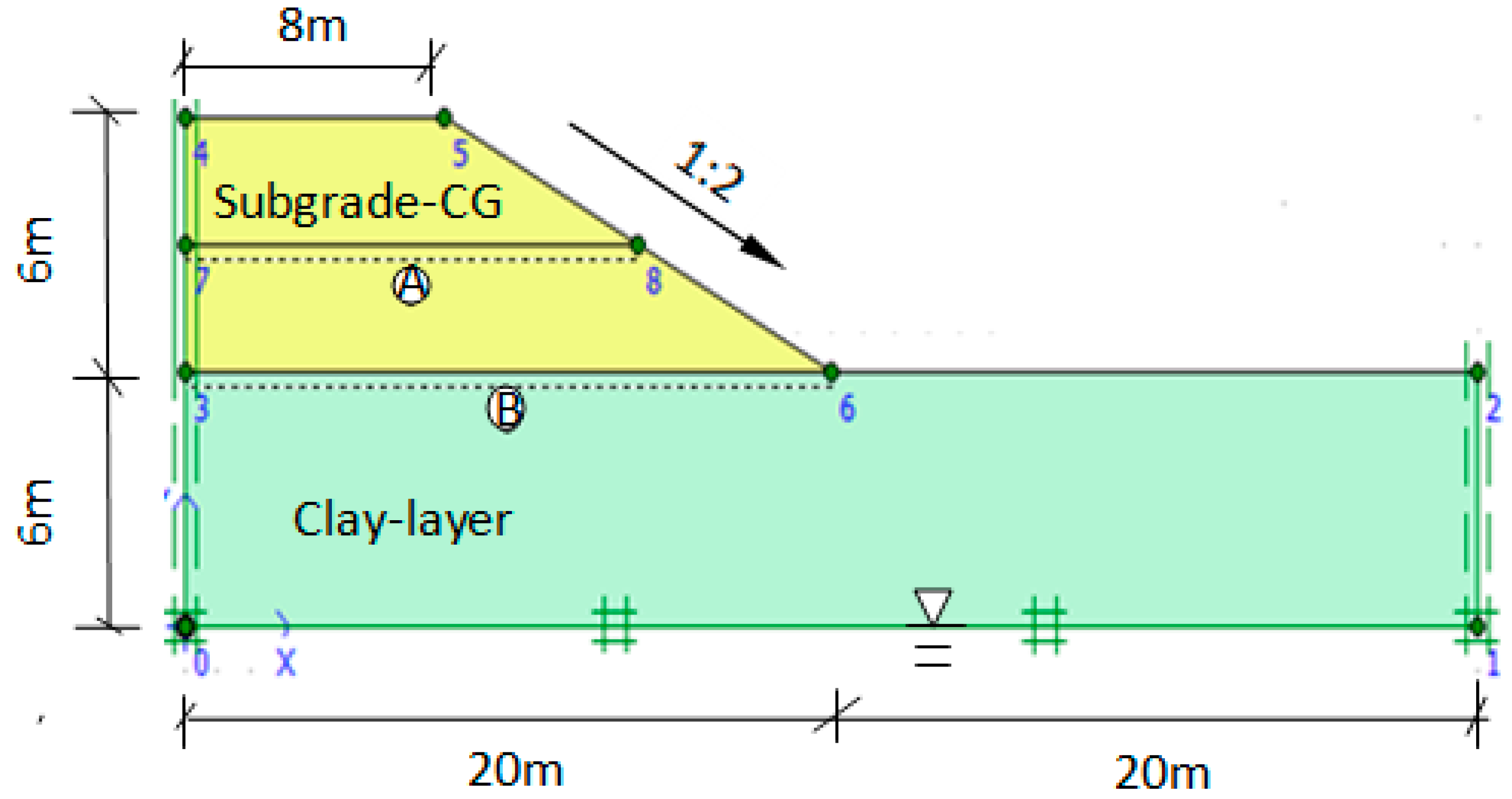
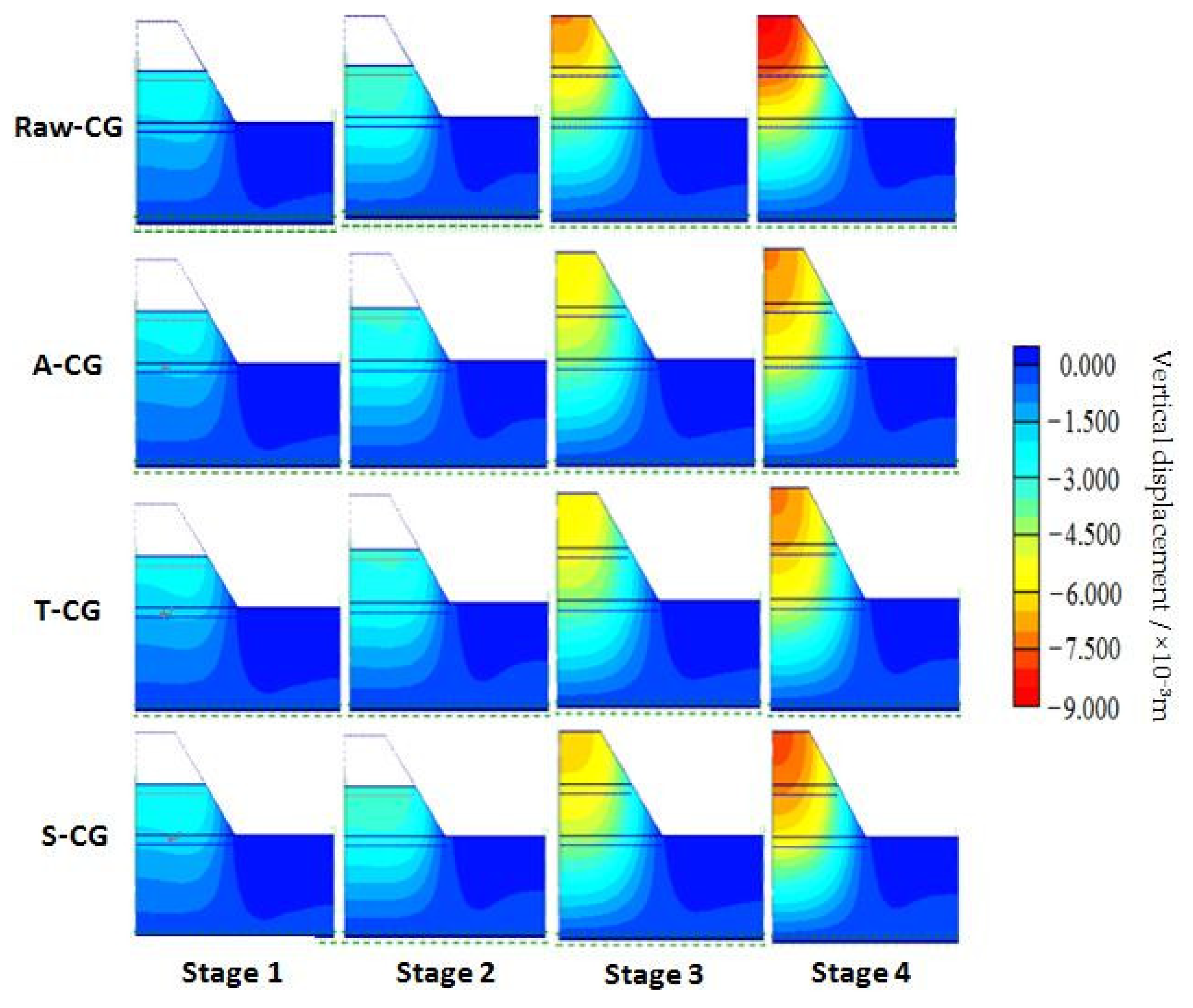
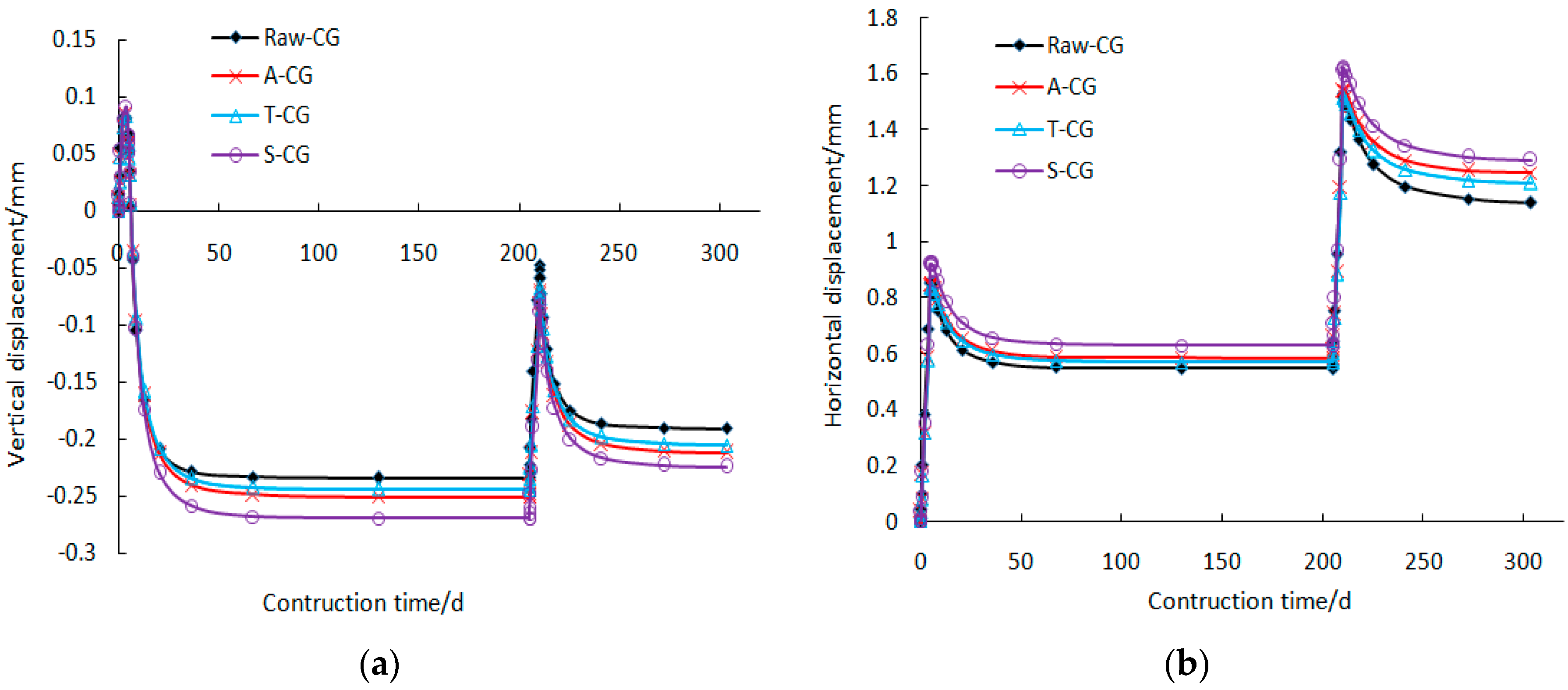
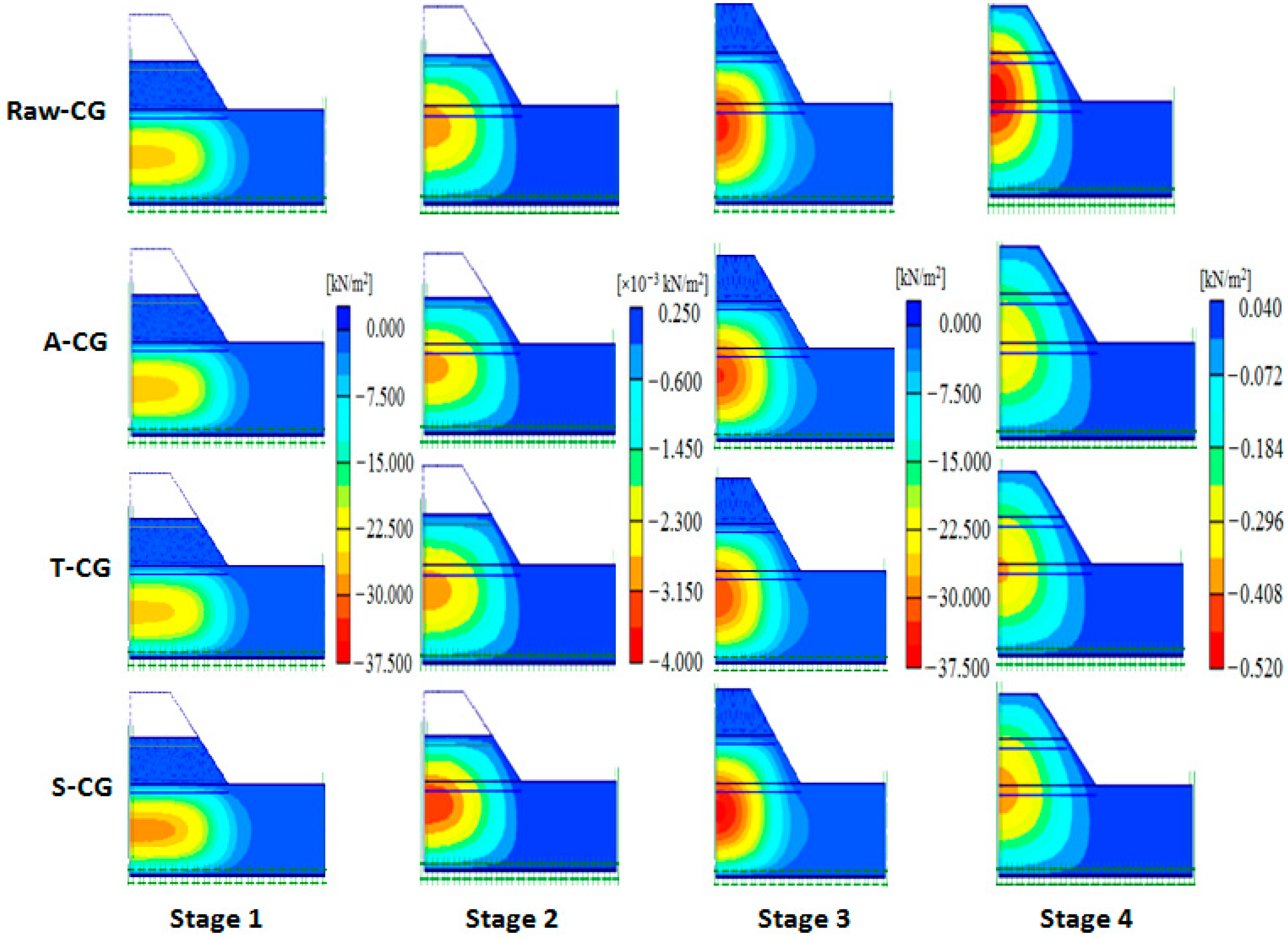
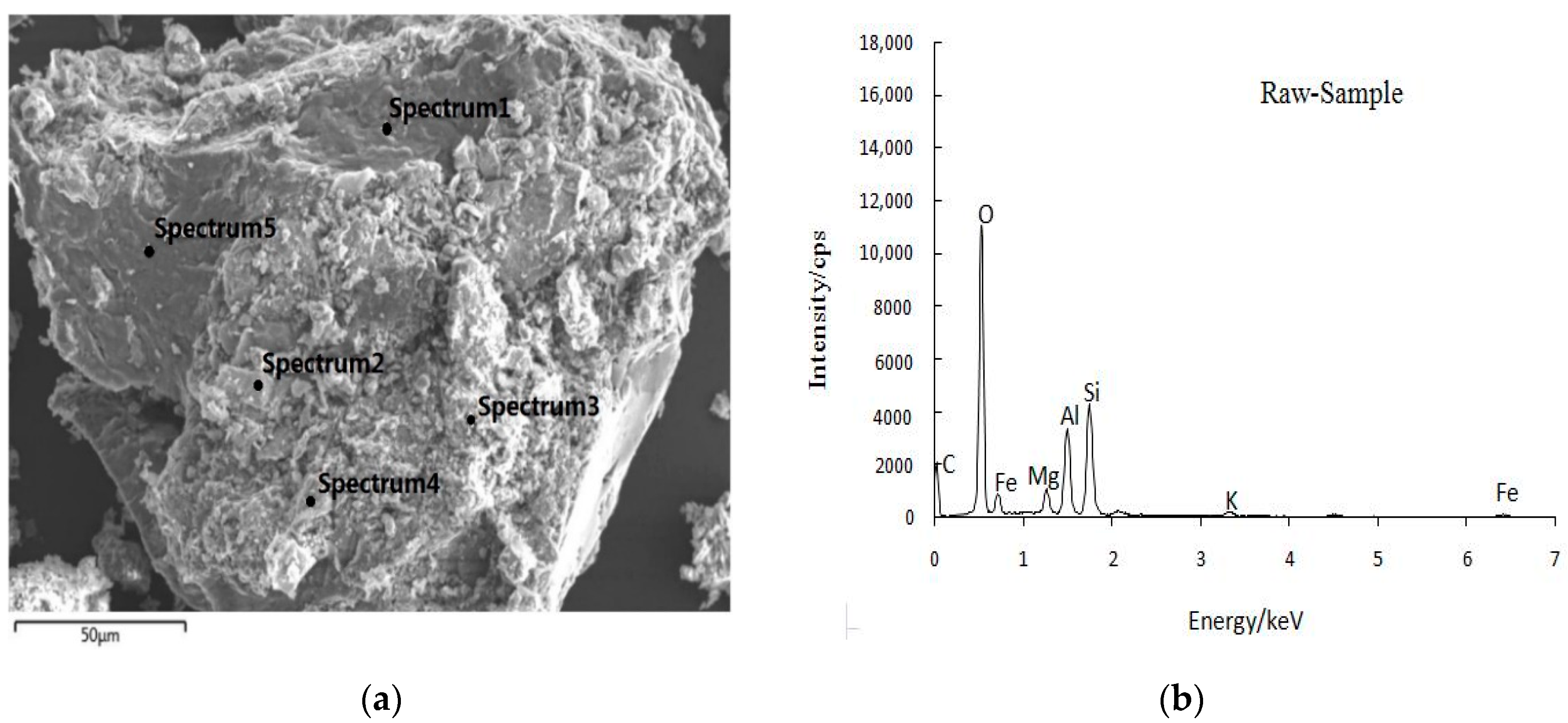
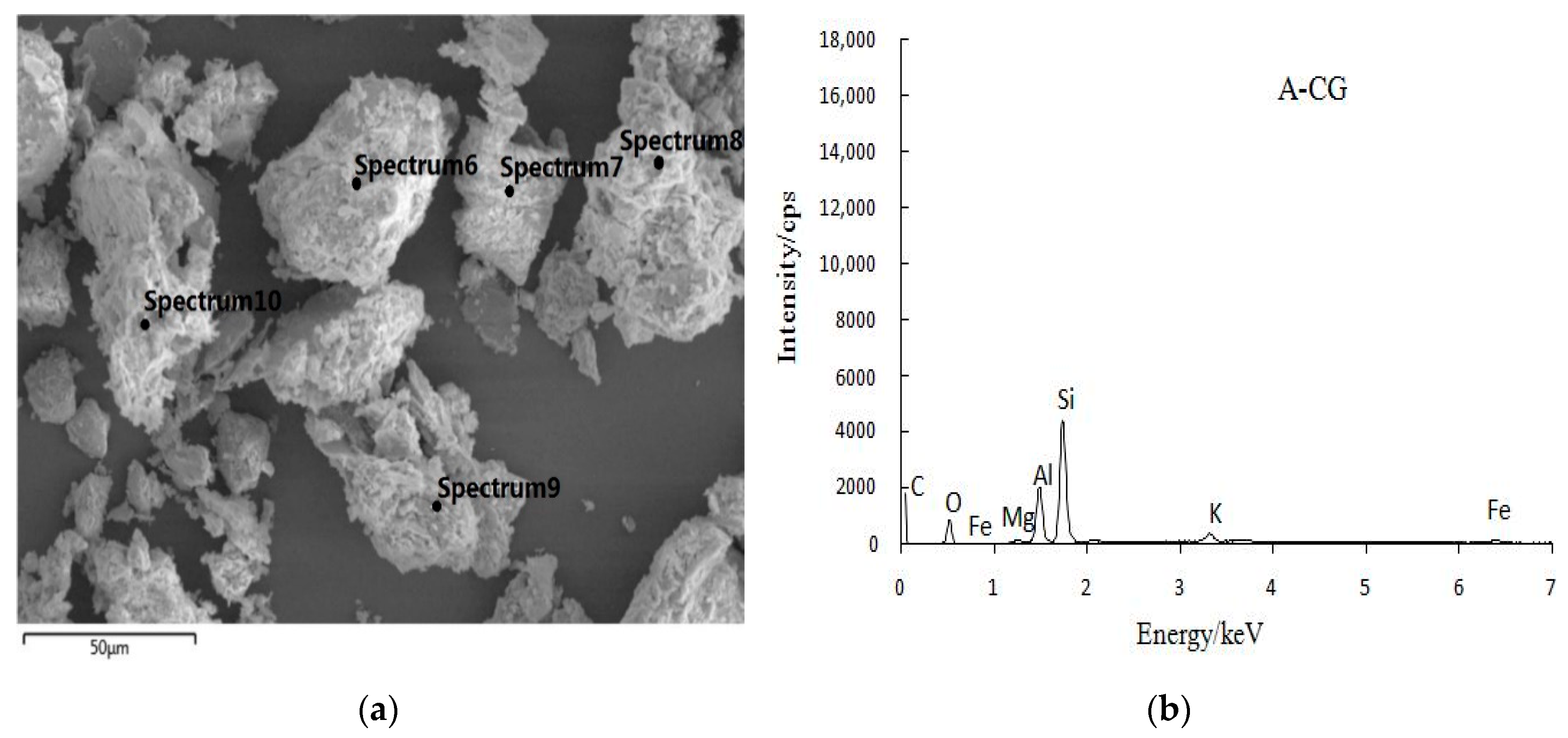
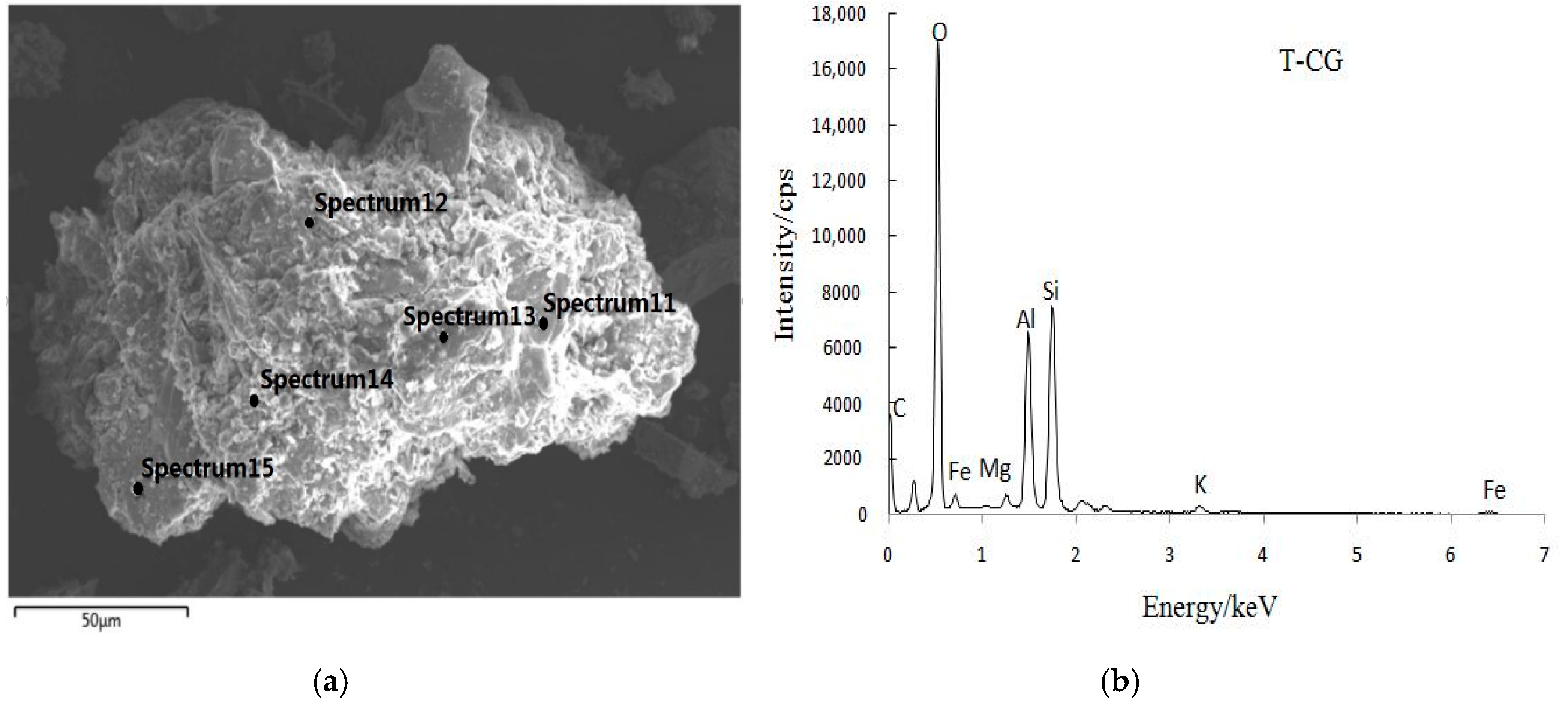
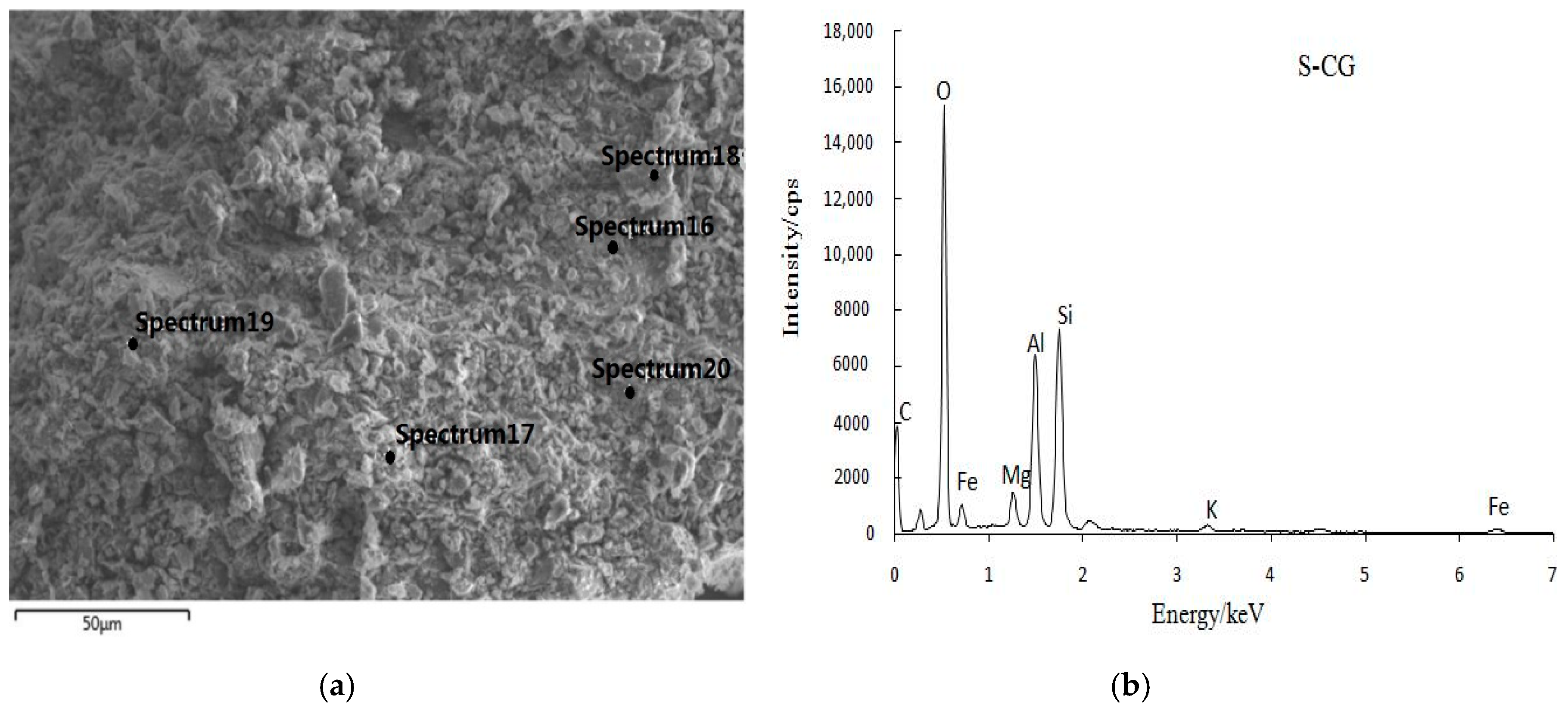
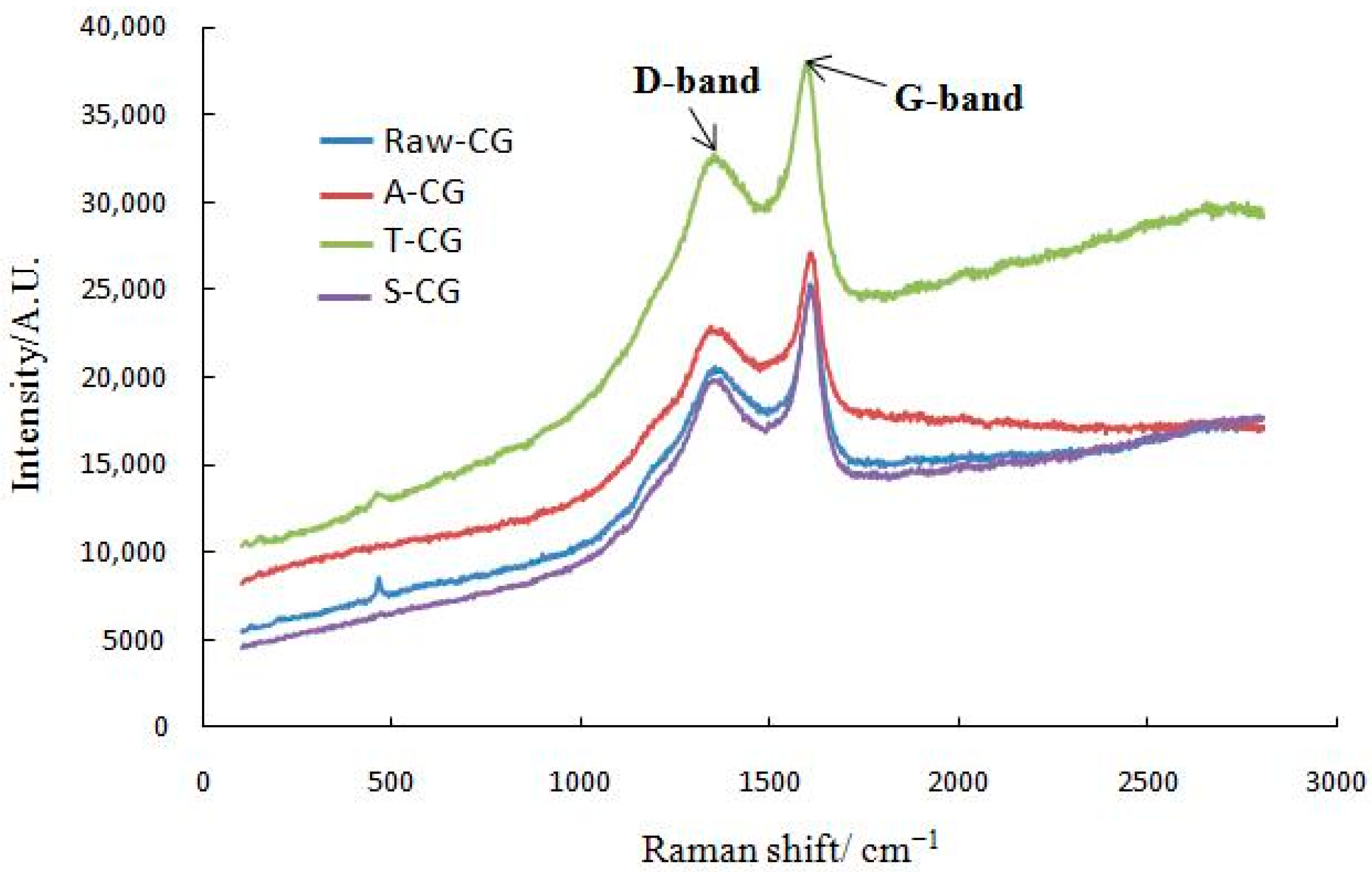
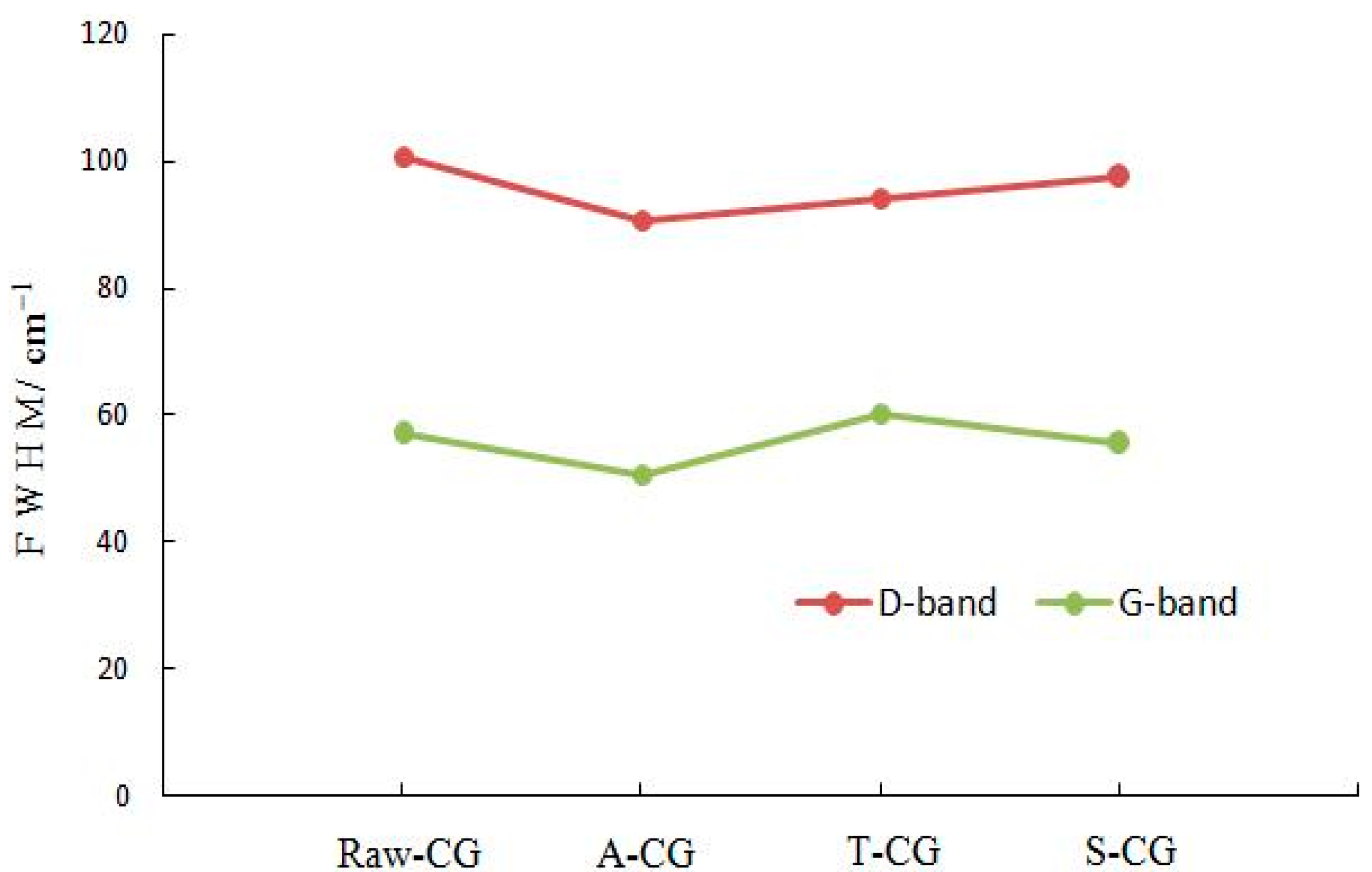
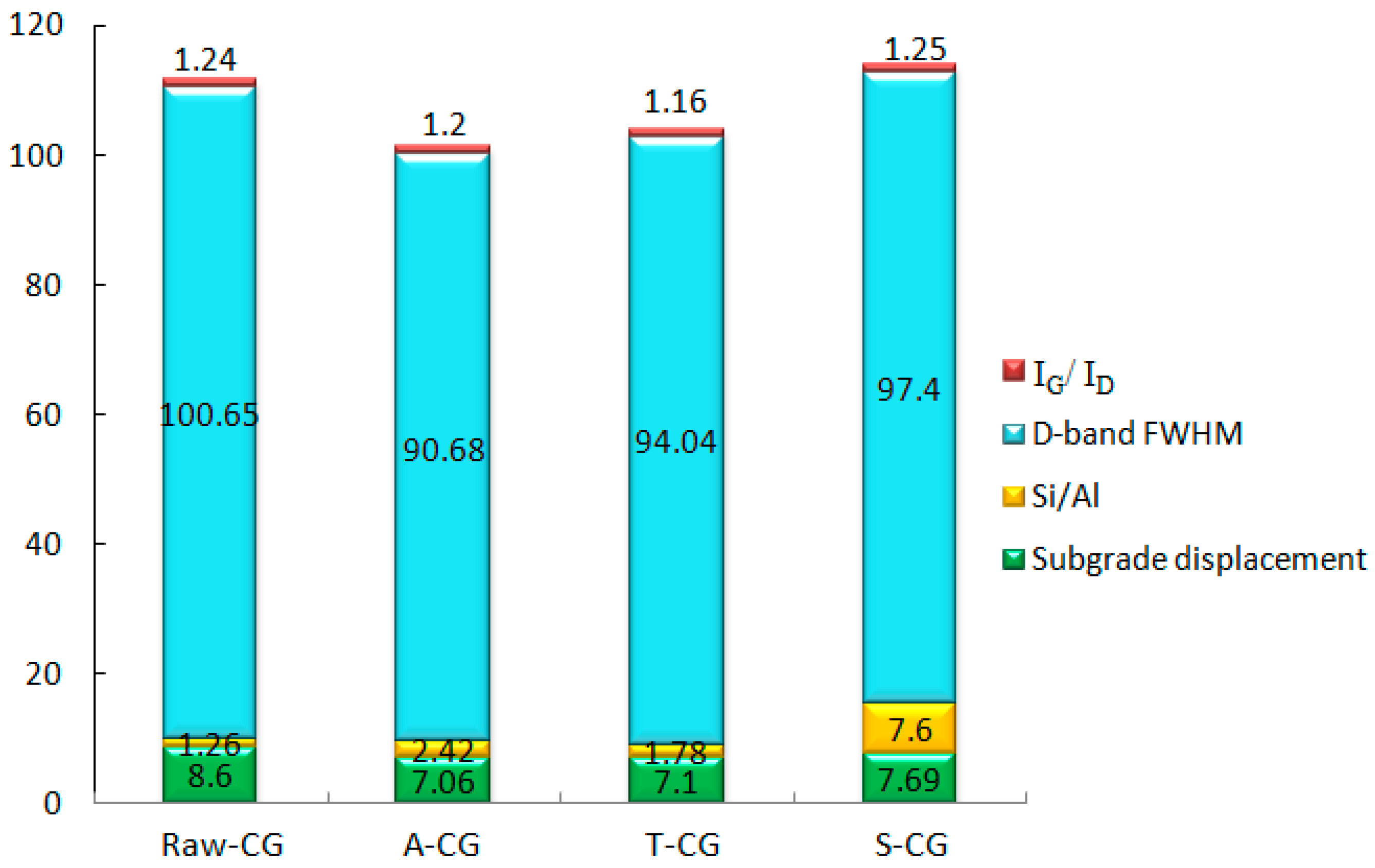
| Composition | SiO2 | Al2O3 | Fe2O3 | CaO | MgO | SO3 | K2O | P2O5 | Na2O | TiO2 |
|---|---|---|---|---|---|---|---|---|---|---|
| Content | 45.8 | 32.8 | 4.5 | 1.1 | 7.7 | 0.6 | 4.1 | 0.2 | 1.2 | 2.0 |
| Sample | Unsaturated Weight/kN·m−3 | E0/MPa | ν | φ/° | c/MPa | ψ/° |
|---|---|---|---|---|---|---|
| Raw-CG | 16.8 | 73.1 | 0.30 | 30.3 | 15.1 | 0 |
| A-CG | 17.0 | 158.3 | 0.30 | 32.0 | 20.8 | 0 |
| T-CG | 16.7 | 142.5 | 0.30 | 30.4 | 9.7 | 0 |
| S-CG | 18.4 | 146.2 | 0.30 | 12.1 | 71.3 | 0 |
| Clay layer | 18.0 | 80.0 | 0.33 | 20.0 | 20.0 | 0 |
| Sample | Stage 1 | Stage 2 | Stage 3 | Stage 4 |
|---|---|---|---|---|
| Raw-CG | −2.68 | −3.46 | −7.05 | −8.60 |
| A-CG | −2.28 | −3.08 | −5.85 | −7.06 |
| T-CG | −2.28 | −3.07 | −5.88 | −7.10 |
| S-CG | −2.50 | −3.37 | −6.35 | −7.69 |
| Sample | A Interface | B Interface | ||||
|---|---|---|---|---|---|---|
| Stage 3 | Stage 4 | Stage 1 | Stage 2 | Stage 3 | Stage 4 | |
| Raw-CG | 3.66 | 5.59 | 4.50 | 5.22 | 8.85 | 8.74 |
| A-CG | 3.84 | 6.39 | 4.19 | 5.18 | 12.07 | 10.18 |
| T-CG | 3.74 | 6.16 | 4.06 | 5.10 | 11.51 | 9.53 |
| S-CG | 4.42 | 7.10 | 4.49 | 5.62 | 12.27 | 10.13 |
| Sample | Stage 1 | Stage 2 | Stage 3 | Stage 4 |
|---|---|---|---|---|
| Raw-CG | 3.917 | 4.104 | 2.552 | 2.363 |
| A-CG | 5.183 | 5.478 | 3.596 | 2.181 |
| T-CG | 3.865 | 3.993 | 2.408 | 2.151 |
| S-CG | 4.403 | 4.656 | 2.829 | 3.105 |
| Sample | Stage 1 | Stage 2 | Stage 3 | Stage 4 |
|---|---|---|---|---|
| Raw-CG | −26.66 | −3.00 × 10−3 | −33.50 | −496.19 × 10−3 |
| A-CG | −27.05 | −2.95 × 10−3 | −32.88 | −330.75 × 10−3 |
| T-CG | −26.54 | −3.02 × 10−3 | −32.45 | −361.84 × 10−3 |
| S-CG | −29.25 | −3.53 × 10−3 | −35.72 | −385.17 × 10−3 |
| Sample | Si | Al | Fe | Ca | Mg | K | S | C | O | Na | Others |
|---|---|---|---|---|---|---|---|---|---|---|---|
| Raw-CG | 15.9 | 12.0 | 3.0 | 0.2 | 1.3 | 1.5 | 0.3 | 27.4 | 38.2 | - | 0.2 |
| A-CG | 24.2 | 10.0 | 2.8 | - | 1.0 | 0.4 | 0.1 | 11.2 | 50.2 | - | 0.1 |
| T-CG | 17.3 | 9.7 | 2.3 | 0.1 | 1.1 | 0.6 | 0.2 | 9.5 | 59.1 | - | 0.1 |
| S-CG | 28.9 | 3.8 | 1.0 | 0.1 | 0.5 | 0.3 | - | 8.0 | 56.9 | 0.4 | 0.1 |
© 2020 by the authors. Licensee MDPI, Basel, Switzerland. This article is an open access article distributed under the terms and conditions of the Creative Commons Attribution (CC BY) license (http://creativecommons.org/licenses/by/4.0/).
Share and Cite
Yang, X.; Zhang, Y.; Li, Z. Embankment Displacement PLAXIS Simulation and Microstructural Behavior of Treated-Coal Gangue. Minerals 2020, 10, 218. https://doi.org/10.3390/min10030218
Yang X, Zhang Y, Li Z. Embankment Displacement PLAXIS Simulation and Microstructural Behavior of Treated-Coal Gangue. Minerals. 2020; 10(3):218. https://doi.org/10.3390/min10030218
Chicago/Turabian StyleYang, Xiaoyun, Yan Zhang, and Zhuhan Li. 2020. "Embankment Displacement PLAXIS Simulation and Microstructural Behavior of Treated-Coal Gangue" Minerals 10, no. 3: 218. https://doi.org/10.3390/min10030218
APA StyleYang, X., Zhang, Y., & Li, Z. (2020). Embankment Displacement PLAXIS Simulation and Microstructural Behavior of Treated-Coal Gangue. Minerals, 10(3), 218. https://doi.org/10.3390/min10030218






